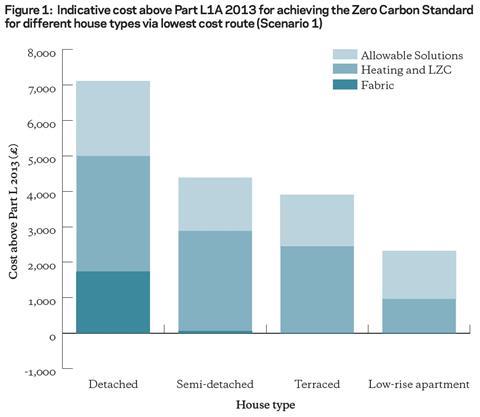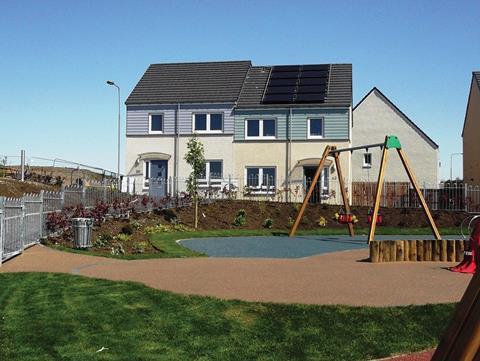The cost to housebuilders of meeting the Zero Carbon Standard for new homes continues to fall. Here, Adam Mactavish of Sweett Group and Nicola O’Connor of Zero Carbon Hub present the key findings of the Zero Carbon Hub’s recent cost analysis of the proposed standard
01 / Introduction
From 2016, all new-build homes will be required to meet tough energy efficiency and carbon saving standards. The carbon emissions associated with regulated energy use in the home must be zero. The cost associated with building zero carbon homes therefore remains an important topic for housebuilders, policy makers and other stakeholders.
This article summarises the findings of the Zero Carbon Hub’s forthcoming report, Cost Analysis: Meeting the Zero Carbon Standard, which considers the implications of the Zero Carbon Standard in comparison to both the 2013 and 2010 versions of Building Regulations Part L1A.
The new analysis shows that the additional costs of the Zero Carbon Standard have continued to decline, driven by ongoing reductions in the installed cost of solar photovoltaics (PV), better understanding of the costs of delivering highly energy efficient buildings and changes to the detail of the standard itself - for example, the level of carbon reduction required and the proposed cap on the price of Allowable Solutions.

02 / What is the zero carbon standard?
The final standard will not be fully determined until the review of Part L of the Building Regulations for 2016. To meet the Zero Carbon Hub’s currently proposed Zero Carbon Standards, each home needs to:
- meet a minimum fabric energy efficiency standard (FEES)
- have total modelled on-site carbon emissions of less than 10-14 kgCO2 per m2 per year - known as Carbon Compliance
- achieve zero carbon emissions from regulated energy use which may be achieved via the use of Allowable Solutions, depending on the outcome of the government’s consultation process.
The standards differ depending on the type of property and are shown in table 1.

03 / Achieving the standard
A range of technical solutions to meeting the Zero Carbon Standard were considered, all of which should be applicable to most new homes. Specific options included:
- Scenario 1: FEES + highly efficient gas boiler + PV + Allowable Solutions
- Scenario 2: FEES + highly efficient gas boiler + solar hot water (SHW) + PV + Allowable Solutions
- Scenario 3: FEES + air source heat pump (ASHP) + PV + Allowable Solutions
- Scenario 4: FEES + ASHP + SHW + PV + Allowable Solutions
- Scenario 5: Advanced energy efficiency + gas boiler + PV + Allowable Solutions
- Scenario 6: Advanced energy efficiency + gas boiler + SHW + PV +Allowable Solutions
- Scenario 7: Advanced energy efficiency + ASHP + PV + Allowable Solutions
- Scenario 8: Advanced energy efficiency + ASHP + SHW + PV + Allowable Solutions
Many other potential solutions could be considered, for example the use of biomass boilers or ground source heat pumps. However, previous analysis has shown that these options are currently less widely applicable than the eight options listed above.

04 / Cost benchmarks
Benchmark costs for achieving the Zero Carbon Standard are based on the cumulative impact of fabric energy efficiency (the minimum FEES or a more advanced standard), Carbon Compliance (the combined performance of the fabric and a heating and/or low or zero carbon energy source), and sufficient Allowable Solutions to address any remaining regulated carbon emissions.
These costs are presented as an extra cost in comparison to a typical solution for achieving either the current 2010 version of Building Regulations Part L1a or the 2013 regulations that come into force in April 2014.
This analysis shows a continuing reduction in the cost of meeting the Zero Carbon Standard for homes with particular reductions seen in the cost estimates associated with installing solar PV and achieving the required performance standards in airtightness and thermal bridging.
Table 2 provides broad cost ranges that are considered to be reasonable for achieving the proposed Zero Carbon Standard in different house types in comparison to Part L 2010 or 2013. The cost ranges are based on achieving the Zero Carbon Standard via the route considered by stakeholders to be the most cost-effective, namely Scenario 1: FEES, a highly efficient gas boiler, PV and Allowable Solutions.
The additional costs over forthcoming (2013) Building Regulations broken down by fabric, heating and low and zero carbon (LZC) technology and Allowable Solutions are shown in Figure 1.
While a Scenario 1-based solution is believed to be the lowest cost and is arguably most straightforward to deliver, other options may be more appropriate - for example, where there is a desire to reduce the amount of PV used or to achieve higher standards of fabric energy efficiency.
Figure 2 provides indicative costs for each of the eight compliance scenarios listed above for a semi-detached /end-terrace house indicating a range in costs from £4,500 to £17,100. Not surprisingly, costs are significantly highest for scenarios with a combination of several heating and LZC technologies and very high levels of energy efficiency.
Further details of the cost analysis including benchmarks for each modelled house type, each compliance scenario and more comprehensive information on the cost build-ups are included in the full study report available at www.zerocarbonhub.org from 10 February.


05 / Projections to 2020
It is likely that the relative costs of meeting the Zero Carbon Standard will reduce further between 2014 and 2016 and continue to fall through to 2020 and beyond. For a detached house, this might mean that by 2020 the additional cost would be about £5,700-6,300 per home, in 2013 prices and compared to 2013 regulations. For semi-detached and terraced homes the costs would be about £2,900-3,600 and for low-rise apartments £1,900-2,000 per home.
We have assumed that a Scenario 1-based solution will remain the most cost-effective approach to meeting the standards. For low-rise apartments it is likely that Allowable Solutions will be the most significant contributor to overall costs (about 70%), while for semi-detached and terraced housing it is likely that the additional cost will be split roughly evenly between PV costs and Allowable Solutions. For detached houses it is expected that the costs of achieving the minimum FEES standard will remain a significant component of the additional costs (about 30%), with PV and Allowable Solutions comprising around 35% each.
06 / Conclusions
It is impossible to estimate with absolute precision what the costs of building to the Zero Carbon Standard could be for every type of house in every scenario. But the review clearly shows a trend of significant cost reductions over time. In the seven years since the zero carbon policy was first announced by the government, compliance costs have fallen by tens of thousands of pounds. At today’s prices, the typical additional cost of building a semi-detached house to the Zero Carbon Standard could be less than £5,000.
However, even though costs are falling, it must also be recognised that the housebuilding industry is in a fragile period of recovery. Industry will need to continue to innovate and evolve in order to keep prices as low as possible. The final Zero Carbon Standard implemented by the government in 2016 must be both stretching, helping to reduce the carbon impacts of new housing, and remain capable of being delivered in a cost-effective manner.
As well as reduced carbon emissions, homes meeting the Zero Carbon Standard should be significantly cheaper to run than current homes. The Hub’s and NHBC Foundation’s research has shown that energy costs for a Zero Carbon Home could be over 40% lower than a home built to 2013 standards and 75% lower than an “upgraded” Victorian house.
Building the high-quality, highly efficient, low carbon homes of the future comes at a cost. Accepting this, one of the Hub’s next tasks on the journey to zero carbon will be to support industry in demonstrating the value of such homes to their customers.

Basis of the benchmarks
The Zero Carbon Hub’s previous analysis was used as the starting point for this analysis. Core assumptions and the benchmark house types have been kept the same:
- Four house types are considered: detached (about 118m2), end terrace / semi-detached (about 76m2), mid terrace (about 76m2) and a low-rise apartment block of one and two bedroom units (average floor area 56.5m2)
- Costs include:
- materials and labour
- allowances for preliminaries (about 12%), overheads, and profit (about 4%) and contingency (about 5%)
- any associated works
- impacts on other development costs (for example, increased foundation costs arising from thicker external walls, and removal of combi-boilers and installation of conventional condensing boilers and dual coil hot water cylinders to support solar hot water systems).
- The cost estimates are considered representative of traditional construction by typical medium and large developers who are assumed to have established supply chain management processes.
Previous analysis has been updated to include:
- additional costs associated with building to the Zero Carbon Standard in comparison to the requirements of Part L1A 2013
- new design assumptions and cost information for fabric energy efficiency measures, air source heat pumps, PV and solar hot water systems
- new assumptions about the quantity and capped price of Allowable Solutions required - that is, a need to achieve zero regulated (but not unregulated) carbon emissions with an Allowable Solutions price cap of £60 per tonne CO2e per year
- information on future cost trends up to 2020.
Important caveats
It should be remembered that the actual costs experienced will be influenced by a wide range of other factors including:
- Location - construction prices are typically higher in London and south-east England
- Inflation and wider economic conditions - the presented costs are for Q2 2013. The costs experienced in the future will be influenced by a great many economic factors operating at local, national and global scales
- Design and size - the required specifications and associated costs for each house type will vary with the design (for example, presence of integral garages) and the size of the property
- Developer size and supply chain - due to their buying power and defined supply chain, larger developers can typically achieve lower material costs than smaller builders.

























No comments yet